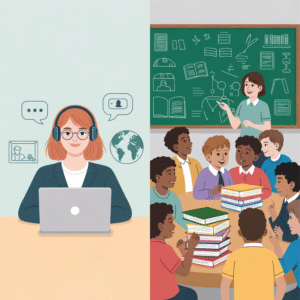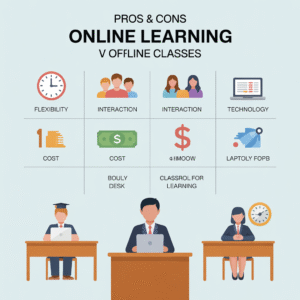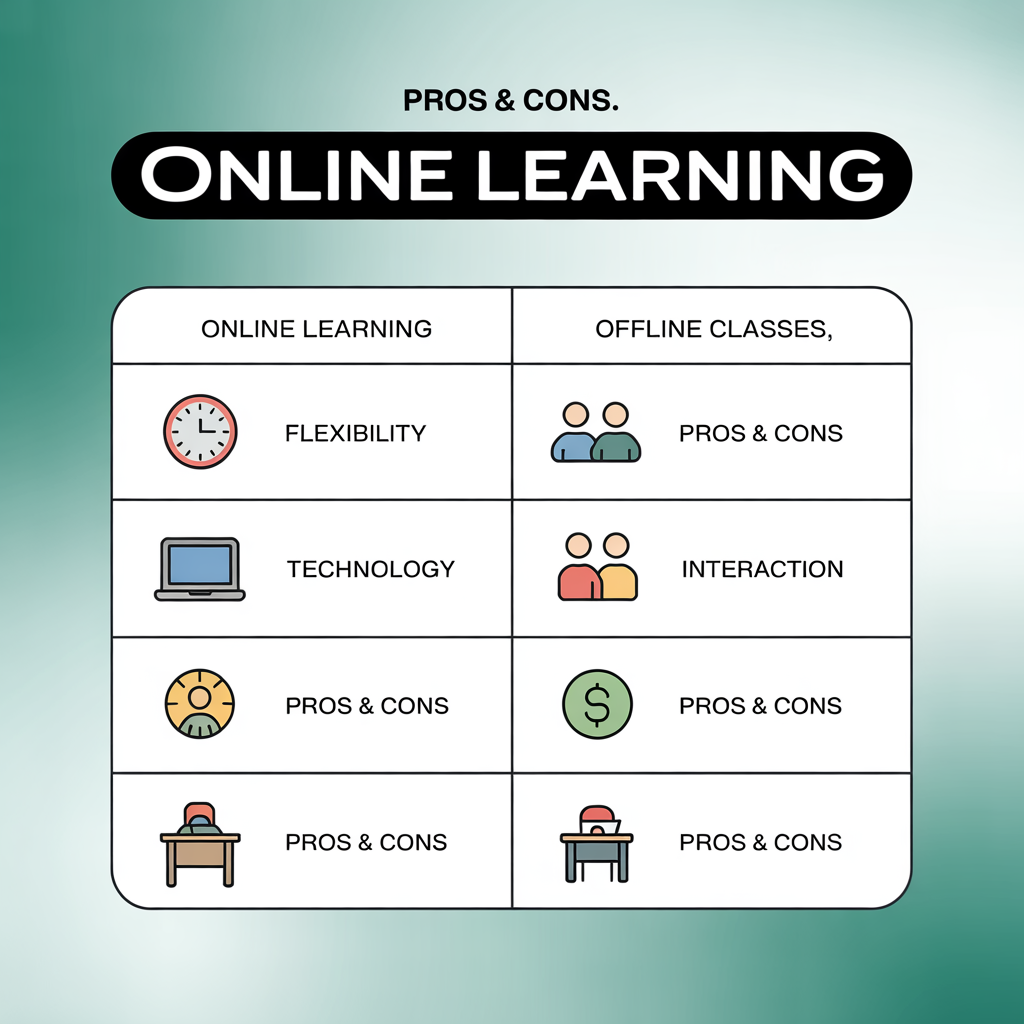Online Learning vs Offline Classes: Pros, Cons & Which is Better? (2025 Guide)

Introduction
Education has always been the foundation of personal and societal growth. Over the years, the way people learn has evolved significantly. From traditional gurukuls and classroom-based systems to modern online platforms, technology has reshaped the educational landscape. Today, one of the hottest debates in the education sector is: “Which is better – Online learning vs offline classes ?”
The COVID-19 pandemic accelerated the growth of e-learning platforms such as Coursera, Udemy, Byju’s, and Khan Academy. Students, working professionals, and educators quickly adapted to digital classrooms. At the same time, traditional offline education remains deeply valued for its face-to-face interaction, discipline, and immersive learning environment.
Understanding Online Learning
Online learning, also called e-learning, refers to the use of digital platforms and internet technologies to deliver education. It can be live (synchronous) or recorded (asynchronous). Examples include:
-
Live Zoom or Google Meet classes
-
Pre-recorded video lectures
-
MOOCs (Massive Open Online Courses)
-
Apps like Unacademy, Skillshare, and Coursera
Key Features of Online Learning
-
Flexibility of time and location
-
Use of multimedia (videos, animations, quizzes)
-
Personalized pace of study
-
Availability of global instructors
-
Affordable and scalable learning opportunities
Understanding Offline Learning
Offline learning or traditional classroom education takes place physically in schools, colleges, coaching institutes, or training centers. It involves direct interaction between teachers and students in a structured environment.
Key Features of Offline Learning
-
Face-to-face interaction with instructors and peers
-
Fixed schedules and structured syllabus
-
Opportunities for group discussions, extracurriculars, and socialization
-
Hands-on learning in labs, workshops, and classrooms
-
Discipline and academic atmosphere
Online Learning: Pros and Cons
✅ Pros of Online Learning
-
Flexibility & Convenience
-
Learn anytime, anywhere.
-
Ideal for working professionals, part-time students, and homemakers.
-
-
Cost-Effective
-
No travel, accommodation, or extra infrastructure expenses.
-
Many courses are free or cheaper than traditional education.
-
-
Global Reach
-
Learn from international universities or expert instructors worldwide.
-
Access to diverse perspectives and teaching styles.
-
-
Self-Paced Learning
-
Students can pause, rewind, and replay lectures.
-
Personalized pace helps slow learners or advanced students alike.
-
-
Use of Technology
-
Interactive simulations, gamified apps, and AI-driven assessments.
-
Helps visual and auditory learners grasp concepts better.
-
-
Variety of Courses
-
From coding to cooking, every skill is available online.
-
Certification adds value to career profiles.
-
-
Accessibility
-
Helpful for students in remote areas or with physical disabilities.
-

❌ Cons of Online Learning
-
Lack of Discipline & Motivation
-
Students may procrastinate without a fixed routine.
-
Dropout rates in online courses are high.
-
-
Limited Social Interaction
-
No face-to-face bonding with teachers and peers.
-
Can lead to isolation and lack of teamwork skills.
-
-
Dependence on Technology
-
Requires stable internet, gadgets, and digital literacy.
-
Not accessible to everyone in rural or underprivileged regions.
-
-
Quality Concerns
-
Not all online courses are authentic or effective.
-
Lack of regulatory oversight compared to traditional institutions.
-
-
Practical Learning Gaps
-
Difficult for subjects requiring hands-on practice (e.g., medical, engineering labs).
-
-
Health Issues
-
Prolonged screen time can lead to eye strain, posture problems, and digital fatigue.
-
Offline Classes: Pros and Cons
✅ Pros of Offline Learning
-
Structured Environment
-
Discipline, timetable, and in-person monitoring keep students focused.
-
-
Direct Teacher Guidance
-
Instant doubt clarification, personal mentoring, and real-time feedback.
-
-
Peer Interaction & Social Skills
-
Builds teamwork, leadership, and communication skills.
-
Friendships and networking opportunities.
-
-
Hands-On Learning
-
Labs, libraries, sports, and extracurricular activities enhance holistic development.
-
-
Less Technical Barriers
-
No need for devices or internet to attend classes.
-
-
Competitive Environment
-
Encourages healthy competition and active participation.
-
-
Credibility & Recognition
-
Degrees and certificates from established institutions hold strong value.
-
❌ Cons of Offline Learning
-
Lack of Flexibility
-
Fixed schedules may not suit everyone.
-
Commuting consumes time and energy.
-
-
Higher Costs
-
Tuition fees, travel, hostel, and infrastructure expenses.
-
-
Limited Access
-
Quality education often centralized in cities.
-
Rural students may struggle to access top institutes.
-
-
One-Size-Fits-All Teaching
-
Teachers follow a fixed pace that may not suit every learner.
-
-
Geographical Barriers
-
Students may have to relocate for specialized courses.
-
-
Limited Course Diversity
-
Offline institutes may not offer niche or trending subjects.
-
Online learning vs offline classes : Comparative Analysis
| Aspect | Online Learning | Offline Learning |
|---|---|---|
| Flexibility | High (anytime, anywhere) | Low (fixed schedules) |
| Cost | Generally lower | Higher (fees + living costs) |
| Interaction | Limited (virtual only) | Rich face-to-face engagement |
| Pace | Self-paced | Teacher-paced |
| Technology Dependence | High | Minimal |
| Practical Learning | Limited (simulations only) | Strong (labs, workshops) |
| Social Skills | Limited growth | High development |
| Global Reach | Easy access to global courses | Mostly localized |
| Credibility | Growing but mixed | Strongly established |
Situational Suitability
-
For Working Professionals → Online learning is better (flexible, short-term certifications).
-
For School & College Students → Offline classes are better for discipline, social development, and structured guidance.
-
For Rural or Remote Learners → Online learning provides access to resources otherwise unavailable.
-
For Practical Fields (Medicine, Engineering, Fine Arts) → Offline learning is irreplaceable.
-
For Lifelong Learning & Skill Development → Online is more practical.
Hybrid Learning: The Best of Both Worlds
The future of education may not be strictly online or offline but a blended model:
-
50% Online → Theory, pre-recorded lectures, revision modules.
-
50% Offline → Labs, workshops, seminars, social activities.
Hybrid learning combines flexibility with structured engagement, making it an ideal future solution.
Expert Opinions
-
UNESCO Report (2023): Online learning will not replace classrooms but will complement them.
-
Harvard Education Review: Blended learning produces better academic outcomes than purely online or offline methods.
-
Student Surveys: 65% students prefer hybrid formats for balance between flexibility and interaction.
Conclusion
The debate on Online learning vs offline classes has no one-size-fits-all answer. Both systems have unique strengths and challenges.
-
If you value flexibility, affordability, and global reach, online learning is the winner.
-
If you value interaction, discipline, and hands-on experiences, offline classes are more effective.
-
For most students, a hybrid learning approach offers the best of both worlds.
Ultimately, the choice depends on your goals, lifestyle, resources, and career aspirations.
Visit : http://aaopadhein.org
Also Read : AaoPadhein Online Tuition: CBSE छात्रों के लिए घर बैठे पढ़ाई का स्मार्ट समाधान
How to Focus on Study: 20+ Proven Tips to Improve Concentration & Study Effectively
